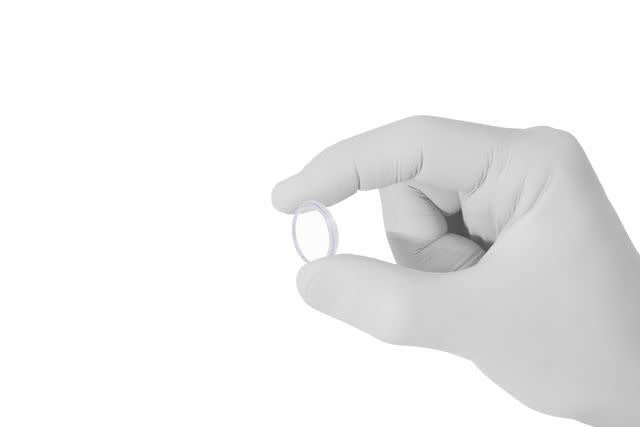What Are Prokera Contact Lenses?
A medical lens used to treat cornea diseases
Medically reviewed by Bryan M. Wolynski, OD
Prokera is a medical contact lens. Unlike traditional contact lenses used to correct common vision problems, Prokera lenses are used to improve healing and relieve pain from certain conditions that affect the surface of the eye.
Prokera lenses are placed in the eye by an eye care professional.
This article discusses how Prokera lenses work and what conditions they help treat. It also covers how these lenses are inserted and what to expect in terms of outcomes and recovery.

BioTissue
Definition
Prokera is a corneal bandage device used to heal conditions affecting the surface of the eye. It's made out of clear, flexible material and houses a piece of amniotic membrane to support the eye's healing process.
Amniotic membrane tissue comes from human placenta, the tissue that provides nourishment and protection to a developing baby during pregnancy. The amniotic membrane contains tissues with biochemical healing properties used in various surgical subspecialties.
The amniotic tissue is taken from healthy, consenting females with no communicable diseases after a C-section delivery. The tissue is fully screened and tested for transmissible diseases, and it's treated with antibiotics after collection.
A Prokera contact lens is larger than a typical contact lens. This lens remains in the eye for the duration of treatment and is not put in/taken out at home like regular contact lenses.
What Is the Cornea?
The cornea is the clear part that sits over the front of the eye. It bends light that enters the eye so that you can see clearly.
How Prokera Works
Prokera provides protection and healing properties that make eye tissue heal faster and produce less pain. They also reduce scarring and decrease inflammation.
To do this, the amniotic membrane acts as a barrier to protect eye tissue and reduce friction with the eyelid. It's also been found to promote cell growth and slow cell death on the outer layer of the eye.
The amniotic membrane also contains fetal hyaluronic acid, which provides hydration, reduces inflammation, and helps with healing.
Prokera may also have antibacterial properties to reduce the chance of infection. This could be due to the amniotic membrane's chemical properties or simply because of its function as a physical barrier.
Conditions Treated
In eye care, amniotic membranes are used as a tissue bandage to help heal conditions of the cornea and eye surface.
Some of the conditions that Prokera treats include:
Chemical burns
Corneal ulcers (sores)
Corneal abrasions and trauma
Bullous keratopathy, blister-like swelling of the cornea
Corneal infections
How to Prepare
Before the day you are having your Prokera lens(es) placed, make a plan to have someone drive you to and from the procedure.
Your vision will be cloudy while being treated with Prokera.
Process to Insert Prokera
Your eye practitioner will insert Prokera in their office, hospital, or surgical setting.
The insertion procedure is fairly simple. You'll be seated in the eye examination chair with your head against the backrest. You may be tilted back in the chair.
Your ophthalmologist or optometrist will rinse the Prokera lens with saline before putting it in the eye. They'll apply topical anesthesia, or numbing drops, on your eye to ease any discomfort.
Usually, Prokera is inserted similarly to a regular contact lens. You'll look down and the practitioner will insert the device up under the upper eyelid, pull the lower lid out, and push the lower ring under the lower eyelid.
The outside rings of the lens are thicker and sometimes cause discomfort. If the lens is very uncomfortable, the medical professional may partially close the eyelid with medical tape.
The lens is typically left in the eye for three to five days. Your healthcare provider may choose to take it out sooner or a few days later. Depending on your condition, you may be asked to come in either daily or in about a week's time for a check-up.
Outcomes
Your eye practitioner can help guide you on what to expect after your treatment. Your outcome may vary depending on the type and severity of your eye condition.
A 2013 study looked at success rates for Prokera for various eye conditions. For patients with corneal ulcers from infection, 44% showed improvement with Prokera. Researchers found higher rates of success in patients with chemical injury, with 80% showing improvement.
Researchers also noted that the treatment was well-tolerated and easy for participants to use.
Another study compared outcomes of patients who used Prokera with those who had an amniotic membrane transplant (AMT) to manage their eye condition. An AMT involves surgically attaching a piece of amniotic membrane to the eye's surface.
Those who used Prokera had a faster healing time, although the total healed area was less than those with an AMT. They also noted that Prokera was a more cost-effective treatment.
Warnings/Contraindications
You shouldn't use Prokera if you are allergic to ciprofloxacin, amphotericin B, glycerol, or DMEM. If you receive Prokera treatment and have any swelling, redness, or discharge, call your healthcare provider.
While wearing the lenses:
Avoid rubbing your eyes.
Keep your eyes closed while showering.
Avoid swimming or anything that soaks your eyes with water.
Don't drive or operate heavy machinery, as Prokera causes blurry vision.
Summary
Prokera is a contact lens used as a tissue bandage to heal eye surface conditions. It protects the eye tissue, stimulates new cell growth, and helps with healing.
Prokera contains a piece of amniotic membrane, which comes from a human placenta. The amniotic membrane has chemical properties that can help eye conditions heal faster.
Your eye practitioner will insert Prokera lenses in their office or a hospital setting. Usually, you'll wear them for about three to five days, but your eye practitioner may suggest getting them out a few days earlier or later.

